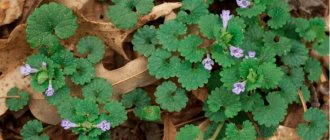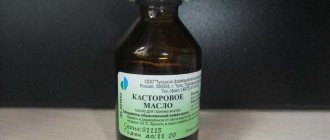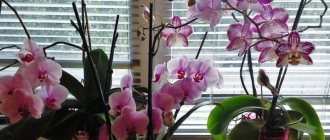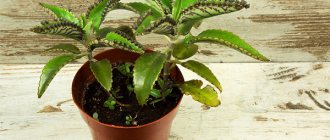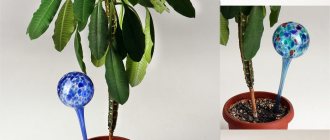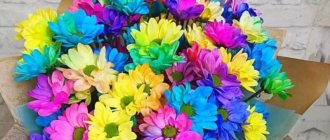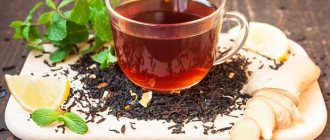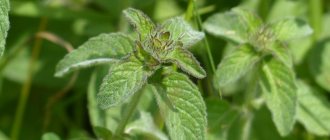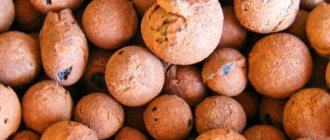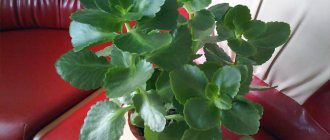A glass container with live plants and decorative elements looks unusual and stylish. Nowadays, all kinds of mini-florariums are in fashion, which can be easily placed on the coffee table, next to the computer. In small volumes, from 1 to 3 plants are used, less often 5 crops. Large florariums are often used to decorate offices or restaurants: huge display cases or aquariums with plants look very impressive. They can accommodate a large number of species, using them to create an imitation of a real tropical forest. But such ecosystems need to be specially regulated using temperature and humidity sensors. They are equipped with automatic watering systems and additional lighting.
- What kind of florariums are there? Closed florariums
- Open florariums
- Transparent container, glass or plastic
- Plants for a tropical florarium
Drainage for indoor plants according to the rules
If there is no “stone” drainage, it is replaced with polystyrene foam and its analogues.
When growing hydroponically, drainage completely replaces the growing substrate; in fact, the entire technology is drainage. In plastic or polymer pots it is easy to make holes yourself, but when purchasing ceramic and terracotta pots you need to evaluate the drainage capabilities of the pots more carefully. 4. Before you start replanting the plant and laying the drainage, make sure that the tools and materials themselves are clean. Check the instructions for the purchased drainage: some types of special expanded clay, vermiculite and perlite need to be saturated with moisture before laying. Agroperlite is not drainage, but one of the best mineral additives for soil. For each planned transplant, create a new drainage layer. It is advisable to use fresh drainage material. The thickness of the drainage is usually divided (conventionally) into low, medium and high. I can only say that high drainage is about a quarter of the height of the pot, medium drainage is up to 1/5, and low drainage is up to 1/6 of the height.
But it should be noted that it does not last forever: after 5 years, expanded clay will turn into something similar to soil, so sometimes it needs to be replaced. You won't be able to use a large pot for it because there is too much risk of flooding, and a small one will be unstable. It is in this situation that it is worth remembering such drainage material as crushed stone. The only downside may be that moss is not always available; you can collect it yourself, or you can buy it.
How to properly arrange drainage
In order to avoid clogging of the holes, an impeccable layer of stones should be laid on the bottom of the tank, thanks to which the liquid will flow out through the holes. A thick layer of soil and roots can also clog drainage holes.
If this happens the next time it is moistened, then you need to start transplanting the flowers into another container with fresh soil mixture.
Material selection
As for what material is best to use for drainage, in this case it all depends on your imagination. In most cases, plant growers prefer expanded clay, crushed stone, polystyrene foam, pebbles, small bricks, gravel, and others. Basically, drainage is laid at a height of 3 centimeters from the bottom of the flowerpot. For individual flowers, fill the pot by a third. Others belong to such plants.
When choosing a material for drainage, flower growers most prefer expanded clay. It is sold in every flower shop. Expanded clay quite easily absorbs moisture, and releases it after the soil dries. The remaining excess water leaves the pot without much difficulty, flowing down the spherical stones.
Expanded clay is a very lightweight material that does not burden the tank with the flower and can serve as drainage for approximately 4 years. When a transplant is performed, it is changed. Expanded clay pebbles can also be used to mulch the top layer of soil. It prevents the formation of a crust and the drying out of the soil. Expanded clay allows water to pass to the roots and prevents the formation of moss and mold.
You can do the draining yourself. Ceramic dishes or bricks are very similar in their qualities to expanded clay. They are all made from baked clay. Expanded clay is a good material for drainage, which is crushed into small pieces before use.
Gravel and crushed stone have good strength. Water flows through them perfectly, and there is no destruction. The only disadvantage of such materials is that they are heavy and the earth is supercooled. Stones do not retain heat, so flowers with similar drainage are best placed on south-facing windows.
Foam is also used for drainage. There is no mold on it and no rotting. Crushed foam does not absorb liquid, allowing it to easily pass to the drainage holes. In addition, polystyrene foam protects indoor flowers from hypothermia. It is quite soft, therefore, young roots often go deeper into it. At the next transplant they are simply eliminated. A layer of polystyrene foam measuring 3 cm is placed on the bottom of the flowerpot, then a small layer of sand and soil. After which you can plant indoor plants.
When transplanting and planting, it is imperative to use drainage for indoor flowers. This will protect the flowers from excess moisture and supply the root system with oxygen.
Under no circumstances should you use eggshells or nutshells for drainage. When moisture affects these materials, they can rot, mold, and affect the acidity of the soil, which ultimately leads to various diseases in indoor plants. If you do not react immediately, the flower may die.
Sand is not yet allowed. When watering, it becomes filled with soil particles and simply clogs the drain holes, which leads to stagnation of moisture at the roots and their rotting. It is permissible to use river pebbles, as long as you need to get rid of the sand.
Professionals do not recommend using granite and marble chips for drainage. This can be explained by the fact that the salts that are present in granite and marble act with water and very strongly acidify the soil.
Drainage includes not only excellent liquid permeability material, but also the ability to reduce flowing liquid. If water regularly stagnates in the stand, then drainage is simply not needed here. This is why it is necessary to drain the excess liquid after the next moistening. If this possibility is excluded, then the tank on the pallet must be placed on an elevation so that the lower part of the tank is in the air and not in the water.
How to make and decorate pots for indoor flowers with your own hands? Possible materials for manufacturing
How to properly use aqua soil for flowers
How to properly use landscape stone on the site?
1. Create a project.
In order for the stone to become an integral part of your landscape relief, you need to think through the concept and design, taking into account the size of the site, the location of the main buildings and style. A five-meter marble Apollo will look comical in a small area with a wooden house, and a miniature rock garden will simply get lost surrounded by huge pine trees.
2. Calculate the required amount of stone
. This is one of the most important tasks: if you buy less stone than you need, you will have to buy more. But it is not always possible to find exactly the same natural stone. Or you might accidentally buy more than you need. Considering the cost of some types of stone, this is, at a minimum, not economical.
3. Lay the stone correctly.
A correctly laid stone is pleasing to the eye and does not cause any problems. But errors during installation not only “smear” the decorative effect of the entire composition, but can also cause damage to plants. At best, the stone element will need to be removed or moved. At worst, you will have to replace the plants.
4. Take into account stylistic features.
A competent combination of species will help emphasize the beauty of the plantings, and the logical repetition of selected combinations throughout the entire territory of the site will allow you to design the landscape in a certain style, avoiding the effect of fragmentation.
5. Maintain the level.
Sometimes the stone element turns out to be crooked. This is due to the fact that the shrinkage of the structure was not initially taken into account or the surface on which it was installed was incorrectly prepared. Even more often there are cases when the stone elements do not match the level of the lawn. Such mistakes are striking and make the area sloppy, even if it is very expensive material surrounded by luxurious plants.
The choice of material and landscape solution completely depends on the taste and wishes of the customer. The stone adds relief, uniqueness, reflects the individuality of the customer and helps create a design full of harmony.
If you want to create a landscape project for your site quickly and professionally, we invite you to the landscape studio of our garden center. Professional designers will bring any of your ideas to life, think through zoning, help you choose plants and materials: your beautiful garden will delight you for years and delight your guests.
Read more about
What can drainage be made from?
Different types of plants require different drainage patterns and sizes. The drainage component can be small, medium or large, but each of them must equally have the following properties:
- not to mold;
- do not rot;
- let water through;
- do not give any chemical reactions;
- do not damage the root of the plant.
Drainage is used not only for house plants, but also for garden ones.
The most popular type of drainage for indoor flowers is baked clay, medium/fine fraction, called expanded clay. Expanded clay has a porous structure and performs its function perfectly. It retains excess moisture, and as the soil and roots dry out, it returns it to them.
In addition to expanded clay for drainage, the following materials are used:
- crushed stone;
- ceramic shards;
- gravel;
- polystyrene foam (or similar synthetic material);
- vermiculite;
- perlite;
- peat;
- sphagnum moss;
- charcoal;
- broken brick.
To make the right choice of drainage material, you need to have information about them:
Polystyrene foam is a good material for drainage, but the flower root gradually grows into it. It is necessary to replant such plants carefully so as not to damage the root system. Ceramic shards are laid out with the convex side facing up, but it is worth remembering that the root can be injured by sharp edges. When using broken shards, they are sprinkled with sand on top
It is very important that the shards are not large in size, otherwise sand will seep through and clog the free space through which excess moisture escapes. Broken brick can damage the root with its sharp edges, so it is used quite carefully in rare cases. White sand-lime brick has an advantage over red clay brick because it is able to absorb moisture and at the same time retain it, and then release it back as the soil dries. Crushed stone and gravel are more often used in garden plots; they have a long service life.
Sphagnum moss has disinfectant healing properties and also retains moisture well. Before using this natural material, fill it with warm water for about half an hour. This procedure will saturate the moss with moisture and get rid of insects.
The only problem is that such moss is not easy to buy; it is often not available for sale. You can collect moss yourself in the fall in wet/wet forest areas. Moss is often used to grow orchids. Charcoal is used not only as drainage, but also as fertilizer. It has an antiseptic effect, adsorbs salts, and regulates moisture saturation. Coal is laid on the bottom of the pot in a 2-centimeter layer, choosing large fractions that will not leak through the holes. He also works according to the system - absorb, then give.
Vermiculite perfectly absorbs all available moisture, as well as fertilizers. After a while, he continues to feed the plant, giving it everything that he initially saved. This lightweight material is prepared by heating clay, which causes the minerals to compress like scales; it is absolutely harmless to the plant. Externally, vermiculite is similar to cork or wood shavings. Perlite has one drawback - its high cost, but otherwise it is an excellent drainage material that absorbs, retains and releases moisture as needed. Outwardly, it resembles white/gray granules and is of volcanic origin.
It is worth considering that drainage also has its own shelf life, for example, expanded clay needs to be changed every 5-8 years, otherwise it decomposes, becoming part of the soil.
Stones for landscape design: varieties
Granite
– one of the most durable and expensive materials. It easily withstands any aggressive manifestations of the external environment, be it snow, rain, hail or temperature changes. Retains excellent appearance with a shiny surface without cracks or chips for years, can withstand high loads. Elements made of granite are especially valued for their unsurpassed stability and are widely used on alpine slides, in the design of retaining walls, in rock gardens and for other landscape elements. The main colors of natural granite are white, black, red. But this stone needs color balancing as its shades are very dark.
Diabase
- mostly green stones with sand-colored veins of volcanic origin. They can be found in purple, black or dark gray. The luxurious glossy shine makes diabase very impressive. The strength of the stone is not inferior to granite: it can withstand temperature fluctuations and high static loads without damage. It is used in design as an element of rock gardens, rock gardens and as a bright accent in monotonous compositions.
Dolomite
- a durable stone with a rich palette of colors from light and warm shades. Among the variety you will find beige, white, and greenish-gray options. Sandstone can be gray, reddish, crimson or yellow. It differs from other stones in its relief surface. Sandstone is a stone with properties similar to dolomite, but differs from it in its palette of shades.
Dolomite and sandstone are sedimentary rocks. Sedimentary rocks, albeit slowly, are still destroyed under the influence of the external environment and lose their decorative properties. The destruction process continues for years, but it cannot be avoided. Therefore, when choosing sedimentary rocks as an element of landscape design, be prepared for their fragility.
Slate
– a strong and stable stone mixture of mica and quartz. Most often, stones are found in black, gray and gray-green shades, less often - yellow, red and purple. The most valuable options are light-colored slates, which delight with their shade and shiny surface. Slate easily splits into thin plates and can be processed, so it is widely used in garden compositions and for cladding building facades, retaining walls and rock gardens.
Jasper
– bright, beautiful, opaque semi-precious stones with amazing patterns in the form of stripes, ribbons and specks. Stones come in blue, red, purple, green or gray colors. In oriental-style gardens, platforms and flowerpots are decorated with jasper stone chips. Blue crumbs are great for creating dry ponds. Large stones act as accent elements in rock gardens and rock gardens. Jasper flagstones are used to cover retaining walls and foundations of houses. Jasper is not afraid of exposure to the external environment and does not lose the intensity of its shade over time.
Quartzite
- smooth shiny stones based on quartz sandstones. The main shade is gray. It is most often found in nature. The rarest type is crimson quartzite, which can only be found in the Onega region. The palette of this type has many shades of pink, crimson or red. Quartzite looks luxurious on sunny days, when its smooth surface reflects the sun, creating sparkling reflections, and inclusions of minerals shimmer in all sorts of shades. Valued for its incredible strength and decorativeness.
Coil
- a hard and durable rock with an amazing color that varies from dark green to light green. Looks great in rock gardens and in the design of artificial reservoirs. Large serpentine stones can become accent elements of a landscape composition.
Migmatite
- when you look at this stone, it seems as if it comes from some unknown planet: an amazing pattern of multi-colored stripes from dark blue to rusty and sand, diligently created by nature itself, and the relief of grooves and depressions create incredible decorativeness. Migmatite is a durable material that can be used without fear in paving paths and as an artistic element in landscape compositions.
It is not advisable to use limestone in landscape design - it is a soft material that quickly collapses upon contact with soil and water. When dissolved, it penetrates the soil, increasing its Ph (salinization occurs). Under such conditions, it is difficult for plants to absorb nutrients, even if fertilizers are applied in a timely and systematic manner.
Proper drainage of house plants
The health and even life of the green pet ultimately depends on how correctly the gardener organizes the drainage system.
With all the abundance of flower pots, one cannot help but notice that the vast majority of them are plastic pots. Experienced gardeners even make additional drainage cuts in the side of the pot when replanting this orchid. The ability of such plants to grow in swamps in their natural habitat does not mean that they can exist in the waterlogged soil of a flower pot. Consequently, fewer holes are made in the pot. But first of all, you must become familiar with the peculiarities of growing each specific type of indoor flower.
This is the cheapest and most readily available drainage material. Moreover, unlike bricks, pebbles and shards, polystyrene foam is much lighter, which means it does not weigh down the pot.
Both the upper foliage part of the plants and the root system must be able to breathe.
This procedure is not limited only to the presence of holes; it is also necessary to use special drainage material.
You need to put the pot on its side and clean them with a stick. Some types of plants have such a developed root system that it fills the entire space of the pot. Through the drainage holes, the roots will be clearly visible and you can easily monitor their condition.
Only materials of inorganic origin are suitable for creating a drainage layer. For example, marble chips are absolutely not suitable for drainage, since with prolonged interaction with water, they significantly reduce the acidity of the soil, making it excessively alkaline.
However, not everyone knows that installing a drainage layer in a bowl is not as simple as it seems at first glance. The drainage system also includes soil that has water- and breathable properties. That is why proper drainage is one of the most important steps when planting indoor flowers. It's safe to say that all indoor plants need drainage, but the drainage system may vary.
You can purchase drainage mixture at a flower shop or at a construction site if, for example, you decide to buy crushed stone. After planting flowers, it is worth checking whether the drainage system works well.
Almost all beginning flower growers believe that drainage is the same expanded clay that is sold in stores. The main one is increasing the acidity of the nutrient solution that the roots consume. You can agree with this statement, or you can argue. In any case, your humble servant has been using expanded clay as a drainage material for many years, and has not noticed any negative effect on plants. Therefore, their calibration and cleaning falls on the shoulders of the grower. At its core, this is also a pretty good drainage material. Before creating a drainage layer from broken bricks, it also needs to be prepared.
The largest shard is placed at the bottom of the pot, in the center of which a hole is made. Then the main substrate is added and the plant is planted. Foam plastic is excellent as drainage for flowers. Poinsettia from the Euphorbia family is an amazingly beautiful plant.
Can such pain be tolerated? How much money have you already wasted on ineffective treatment?
The use of organic materials for drainage - nut or eggshells, tree bark - is strictly prohibited. For more information, you can watch a video on how to make your own indoor plant drainage. It is prohibited to use materials such as marble and granite chips, especially the first one, as drainage.
What are drainage holes and why are they needed?
The pot must have a way
to drain excess water. To do this, holes are made at the bottom of the pot, which are called drainage holes.
Their number can vary from one to one and a half dozen depending on the characteristics and needs of the flower.
If there are no holes in the pot, then you can make them yourself without any problems. And humidity control
soil begins already at this stage: the thicker the holes are, the faster the water will leave the pot, and the more oxygen the root system will receive.
The number of holes has a similar effect on the removal of moisture and enrichment of soil with oxygen.
Drain hole
Over time, it can become clogged with soil mixture, drainage or roots. Therefore, it needs to be checked periodically, especially when there is only one. If you notice that the hole is clogged, it should be cleaned. A wooden or other stick will do for this.
Other elements and basic requirements
What material is used if the necessary elements are not at hand? If you cannot find any of the above materials, do not worry, there is always a way out. Use what you have on hand. So, what can replace drainage?
- Crushed stone and gravel. Drainage made from these stones perfectly replaces the traditional one. The only drawback is that these elements significantly make the pot heavier. So if you take a small pot or one that you won’t often move from place to place, this material will work best.
- Aquarium stone. Such stones are a good alternative, but the price is quite high. But if you have this material, why not use it?
- Styrofoam. Foam plastic perfectly replaces the usual elements. It meets the necessary requirements, and besides, it can be found almost everywhere. People tend to store boxes of appliances or household appliances, so there is no better budget option for drainage. True, they don’t crumble it into a pot, but cut it into cubes and lay it in a layer of several centimeters. Of course, a significant disadvantage can be damage to the root system if the roots of the plant entwine the foam.
- Brick. You can also replace traditional materials with broken bricks. This is a natural material with the necessary properties. However, before placing it on the bottom of the pot, sharpen the edges, otherwise the roots of the plant may be damaged. White brick is better suited for use rather than red.
We also mentioned the basic requirements earlier. It is necessary to ensure that the drainage has the necessary properties and does not harm the plant. This will be enough to achieve the desired result.
Answers from experts
Leka+:
In addition to expanded clay and brick chips, you can use small pebbles (aquarium grade), shells (if you suddenly have a bunch of unnecessary ones from the holidays), you can simply break old clay pots or unnecessary cups and plates. For very small plants and small pots, you can use coconut fiber or pieces of natural loofah or sisal sponges and pieces of natural sponge. And as a temporary measure (while the cuttings are rooting, while the seedlings are growing) - even pieces of polystyrene foam
A.T.:
Broken brick!
In large pots, when the root of the plants is small, then half of it, sometimes even more, is filled with cones
Galina Zelinskaya:
Crushed RED brick, expanded clay
Irina:
If the pot is large, but expanded clay or bricks are not at hand, then you can use used tea bags. which should be placed on the bottom of the pot in one layer.
Marina Chepurnaya:
expanded clay, foam plastic
Nina Tuzova (Kvashnina):
pistachio shells. advised. but I haven't tried to do that myself
Elena Protopopova:
Bricks, pebbles, old shards, etc. WASH ONLY!!!
Anna Glivatskaya:
You can use walnut shells, just pre-treat them in a manganese solution
Ms. Flora:
And also pine bark, it is useful not only for orchids, as an antiseptic, but it is good to put it on the bottom or in the soil. It both disinfects and drains.
Maximka:
Why shells? Not all plants need this lime. Shards, expanded clay and even pieces of foam.
avmir:
Broken brick, crushed stone, expanded clay, but not shells. And generally avoid limestone, chalk, and gypsum.
Tane4ka:
I don't think shells are a good idea. Sea salted ones need to be washed, washed, washed. Again, the edges are sharp and the roots may get cut. And they will alkalize. Expanded clay or small stones are better.
Clementine Lady:
I like expanded clay as drainage. Lightweight, washes well when replanting, does not injure the roots, there are large ones and small ones, for any holes in the pot. I didn’t notice any disadvantages when using it.
Irina K:
You can use coals from a fire
Irina Smirnova:
I like to use pebbles and gravel. Easily found on the street, in any size. Then just wash it thoroughly and put it in the bottom of the pot. Excellent drainage is obtained. Sometimes I use expanded clay, but not all plants like it. For example, I have adeniums. They do not tolerate expanded clay. As soon as the roots in the pot grow to the expanded clay drainage layer, the leaves immediately begin to turn yellow and drop. For a long time I struggled with the problem of yellowing leaves, until someone here on “ANSWERS” told me that I need to give up expanded clay for adeniums. I replaced the expanded clay drainage with fine crushed stone - everything was fine. Well, Adena doesn’t like expanded clay...
Photo Lady:
I always place one large flap of flat shell in the center of the drain hole. So that the roots don't get out there. In general, all my pots have many holes, so the bottom layer is pebbles, very large bark (I have mostly orchids, but there are others), large pieces of charcoal, and then the necessary soil or substrate. Pebbles are also needed to weigh down small pots. In large plants I put a pebble in each hole. at the bottom of a huge pot. The water drains, but the earth does not wake up.
tsuatsua tsautsautsa:
It is better to do drainage s polyfacture /catalog/livnevaya-kanalizatsiya/ correctly and efficiently, so that the flowers are watered constantly, then there will be no problems, this is called storm drainage.
Succulents for the garden in a jar
Succulents are the most popular when creating florariums, and for good reason. They are usually easy to care for, small in size, do not grow too quickly, and look exotic and different. Moreover, even one type of succulent can differ significantly in appearance, be of different shapes and have different colors of “leaves”, different flowers, etc. Just keep in mind that they do not like high humidity, so when choosing a vase, choose one with a wide neck. And one more thing: they will need to be watered very rarely, and so that not the entire layer of soil/sand gets wet. It will be necessary to make a thick drainage layer, and use coarse sand with the addition of soil as soil.
Try making your first florarium from succulents and cacti
Haworthia
Does not bloom, but has decoratively colored lancet leaves. Undemanding to temperature and humidity conditions. Can be used in combination with more demanding plants. It does not like wet soil too much and can rot if moisture gets into the sockets.
Easy to care for Haworthia succulents
Aptenia
Flowering plant, small bright pink, lilac, white flowers. The leaves are fleshy and small. It is not too demanding on growing conditions and tolerates both high and low humidity.
Aptenia can be successfully grown in a vase
Monanthes
There is Monanthes in the form of a very small shrub, and there is a herbaceous one. Can create cushion-like dense clumps. The stems are erect with a leafy rosette at the top. Some species are in bloom. It is not too picky about temperature, does not like high humidity, but needs good lighting. A period of rest with a decrease in temperature in winter is desirable.
Small-sized plants are suitable for the smallest florariums
Piaranthus
It has a very unusual shape - the stems are creeping and consist of segments. Each segment has several “teeth”. Combined with its unusual coloring - various shades of green and brownish-green, and the star-shaped flowers - this plant will attract attention. Can be the center of a composition. The care requirements are low; you should only protect them from direct sunlight in the summer.
Unusual bright flowers and strange stems
Argyroderma
The very unusual shape of the plant, combined with the silvery tint of the leaves, gave rise to their popular name - living stones. The shape of the leaves resembles small pebbles (usually no more than 2 cm), from which a large and bright flower grows. It is generally undemanding in terms of conditions.
Flowering stones are an interesting addition to a glass garden
Conophytum
This type of succulent is also called living rock. The shapes of the leaves are even more strange and unusual. The flowers are very similar to daisies - bright and large. They have a clear growing season and dormancy. Vegetation usually occurs in winter, dormancy occurs in the summer months.
The shapes of the leaves are the most unusual. And these plants live on Earth?
Echeveria
This type of succulent is also called stone rose. Care is simple, just don’t touch the leaves with your hands. They are covered with a thin coating that wears off when touched. But since the florarium is an almost closed container, the likelihood of plaque damage is low. Another feature is that a rest period with a temperature of about 15°C is required.
The stone rose is not that unusual, but it looks great on rocks and sand.
Lithops
Lithops also look like stones that suddenly bloomed. They differ in that they can change the color of the leaves to match the color of the soil. They grow very well on rocky soil and can withstand high temperatures. They are similar in care to cacti, so they can be combined. They grow slowly and require bright light for normal development.
Another plant from another world
These are not all succulents and there are also no less interesting ones, but even these are enough to create a couple of thousand different compositions.
What is drainage and what is it for?
Most houseplants require a soil composition that provides approximately 15% air, 50% solids and 35% water. Only a properly constructed drainage layer can create such optimal conditions.
This is explained by the fact that with excessive watering, the same percentages of air content that are vital for flowers are displaced. When there is no oxygen in the soil, pathogenic bacteria begin to develop, the root system rots, and the flower begins to wither.
Drainage for flowers, photos of various types of which are presented in the article, precisely ensures the removal of excess moisture and ventilation of the roots.
To lay the drainage layer, you can use various materials, such as gravel, foam plastic or any synthetics, expanded clay, moss, crushed stone, charcoal, broken brick, river sand, peat and others. Next, the most commonly used materials will be discussed in more detail.
An important quality of drainage is good water throughput, chemical inertness, resistance to rotting and mold.
Drainage for flowers has different fractions, which are selected depending on the plants.
How to properly lay a drainage layer
It is important not only to choose the right materials, but also to properly lay the drainage layer
What rules exist that you absolutely need to pay attention to? Let's consider the main postulates:
- The main issue is the thickness of the drainage layer. The average height is about 2-3 centimeters. However, the specific height of the interlayer is determined by 3 factors: The shape of the container. If the pot is narrow and high, then the layer should be approximately 1/4 of the height (after all, the soil in them takes longer to dry out), if it is wide and low, then 1/8 (the soil dries out faster), if the vessel is standard and has a proportional width and height , then the layer size is 1/6 of the height.
- The material from which the vessel is made. If the plant is planted in a container that has a porous structure (for example, clay), then the drainage may be less; if the container is airtight (for example, glass, plastic, glazed ceramic), then the layer should be larger.
- Dimensions and number of drainage holes. The number of holes affects the thickness of the layer: the more there are, the smaller the layer can be, and vice versa, the fewer holes, the thicker the layer should be. However, the diameter of the holes also plays an important role: if the holes are small, then the layer should be larger and vice versa.
Materials for the drainage layer can be reused (with the exception of perlite or small stones, small expanded clay, crushed brick; it is quite difficult to separate them from the soil). After removing them from the bottom of the container, they must be washed, disinfected (for example, in a dark solution of potassium permanganate or chlorhexidine) and dried.
- When planting or replanting any plants, you must use new, clean and dry materials! Do not place dirty or undisinfected materials. If you bought drainage in a store, read the instructions.
- If you buy a houseplant and it comes with instructions, be sure to read them carefully. Drainage requirements may be specified there.
- It is optimal to make drainage in 2 layers: on the bottom there is material of large fractions (expanded clay, crushed stone, gravel, ceramic chips), and on top put smaller elements (perlite, broken brick or at least coarse sand).
- If you use only fine-grained materials, then sprinkle a small layer of soil on them before planting.
- The drainage layer must be even. After planting the plant, you need to carefully walk along the walls of the container and shake it slightly so that the material is evenly distributed.
How to make a florarium with your own hands?
To make your own florarium you will need:
Transparent container, glass or plastic
You can buy a ready-made one or look for it at home and adapt what you have on hand - jars, glasses, bottles, teapots and vases. Ready-made florariums can be found in almost any shape - cube, sphere, hemisphere, cone, cylinder, dome, but geometric florariums are the most popular.
For tropical florariums and orchidariums, containers with a small hole that create high air humidity are more suitable.
For succulents, you need to use containers with a wider mouth as they prefer low humidity levels.
Open type florariums
Drainage
Expanded clay (with a fraction of less than 5 mm), pebbles or sand. Its layer should be larger than in a regular pot, at least 4 cm. In ready-made closed florariums, a double bottom is often used to remove excess water.
Florariums are very beautiful, where differently colored colored sand is used as a drainage layer.
Unfortunately, sand tends to mix up when watering, so in this case, try to plant the plants in the center of the container and water very carefully. This allows you to extend the decorative effect of the “layer cake” longer.
Plant substrate
Succulents will need a light sand mixture, orchids will need a special soil based on tree bark, the rest will need regular ready-made soil with the addition of perlite and vermiculite (30% of the total amount of soil).
It is better not to overdo it with fertilizers, use half doses. Plants that quickly begin to grow will spoil the appearance of the florarium.
Ingredients for an open florarium
Plants for florarium
Even a beginner who has never kept indoor plants before can master a florarium made from succulents, but creating a tropical forest will require a more serious approach and some knowledge.
Decorative elements
„Mosses. Most often they use sphagnum or mosses of various types, which can be found in a pet store or aquarium department. They can only be used in tropical florariums.
Colored glass. „
Stones, shells.
Natural materials: twigs, driftwood, dried flowers. Their use gives the composition a feeling of naturalness.
Decorative figures. They allow you to create a special or some small plot.
Brief description and necessity
It is quite simple to explain why and why this component is so important in the field of growing flowers. The thing is that without drainage, the soil gradually becomes compacted and dries out unevenly from moisture. In addition, areas with excess moisture appear, which can turn sour and cause rotting of the root system. Experts say that the spread of dangerous diseases and pests, lack of air permeability and rotting of the soil, disruption of the normal outflow of excess moisture, as well as an anaerobic environment are not all the factors that a small layer of drainage at the bottom of the container can successfully cope with.
Experts note that such material is a universal soil drainage system that helps maintain the most favorable substrate moisture for each type of indoor plant. Simply put, this is a specific layer of coarse or coarse-grained materials at the bottom of a flower pot, which guarantees good air permeability to the soil, as well as optimal drainage of excess moisture.
Novice florists often forget that good air permeability plays an important role in the process of growing a healthy plant. After all, only in this case will the root system of the flower be able to breathe and develop normally.
https://youtube.com/watch?v=DQghHByiU1w
Common Mistakes
When installing drainage, inexperienced gardeners often make mistakes that lead to disease and even death of plants. And the most important of them is the use of inappropriate materials. There are several of them:
- sand
- tree bark, tea leaves, nut and egg shells
- marble and granite chips.
So, for example, sand at the bottom of a flower pot will not only not drain away, but will also retain water, preventing it from evaporating. And a violation of the water balance will lead to acidification of the soil and the development of putrefactive processes, which in turn will negatively affect the health of the plant. In addition, sand can completely clog the drainage hole.
Tree bark, tea leaves, nut and egg shells are components of animal and plant origin that may contain a number of pathogens. Because of this, there is a high probability of mold and other fungal diseases developing in the substrate.
Shards of granite and marble enter into a chemical reaction with water and can change the acid-base balance of the soil.
Another common mistake made by beginners is letting water stagnate in the tray of a flower pot. The fact is that if excess moisture is not drained, the drainage system simply will not work. For the vast majority of plants, the tray must be emptied of excess water 30-40 minutes after watering.
Here, perhaps, are all the nuances of arranging proper drainage in a flower pot.
Best answers
avmir:
When I was a snotty kid, there were only ceramic pots with one hole in the bottom. This hole was covered with a shard from broken dishes, and as soil they took soil from a garden or forest belt and mixed it with coarse river sand (cherozem from molehills was especially valued). That's all the drainage, and also a good nutritional substance.
Alisa Doronina:
Crushed polystyrene foam.
Academician:
Broken brick, if there is no expanded clay, although it costs a penny.
Lirriella:
Why replace it? Useful thing. Expanded clay works well. Or, if you grow it on a wick, you don’t need it.
riba xitraya:
sphagnum, but expanded clay is best
Polystyrene foam is essentially not drainage, but... fill in the excess volume so that there is less soil, less risk of flooding. It does not come into contact with water, and the essence of drainage is to absorb excess water and release it at the right time
SPINY LIKE A HEDGEHOG...:
Throw any stones...
Clementine Lady:
Expanded clay, ceramic fragments, polystyrene foam. You can add agroperlite to the soil, it will prevent overflow.
Irina K:
Pieces of charcoal are very good for use as drainage.
I:
crushed stone or fine gravel ideal for drainage
Elena Rudenko:
That's what drainage is for, to absorb excess moisture (if the plant is flooded). It’s better not to stuff nonsense into the pot, like polystyrene foam, which doesn’t perform its intended function. It is better to purchase high-quality drainage. I buy Flower drainage large and small from Fusco. It completely and completely fulfills its function.
Ruslan Ladushkin:
You can, in principle, use a drainage system quite cost-effectively now) acoline ordered excellent prices here. and the guys there are great. In general, it’s up to you to decide, but I really advise you won’t regret it)
Evgeniy Volkov:
acoline/
Tropics in the aquarium
Many consider florariums to be exclusively compositions with tropical plants or those that love high humidity. Since there is no clear terminology, this point of view cannot be called erroneous. In any case, this is also a mini-garden, but not in a glass or jar, but in a more or less large aquarium.
In a large space you can create more interesting compositions
When choosing plants for a florarium with tropical vegetation, the determining factor is the growing conditions. The second thing people pay attention to is the size to which an adult plant grows. Another point is the growth rate. The best choice is slow growing. Below is a list of plants that are recommended for such compositions.
- Rosette Fittonia (Verschaffelta, silver veined, dwarf species)
- ferns
- episcia
- Pilea
- royal begonia
- nephrolepis
- Cryptanthus bromeliads
- Pilea parvifolia
One of the most popular plants for growing in a florarium is Fittonia.
- nephrolepis
Air plants can live without any soil at all.
- ivies (Spetchley, variegated, Little Diamond, Tre Coupe)
You can create themed compositions
- violets
arrowroot
Each group has a large number of varieties that differ not only in color, but also in size. You can always select a group with similar care and growing conditions, and one that will not grow very quickly. Another option is plants that can tolerate frequent pruning. Or rather, they don’t react too negatively to them. In high humidity conditions this can become a problem.

